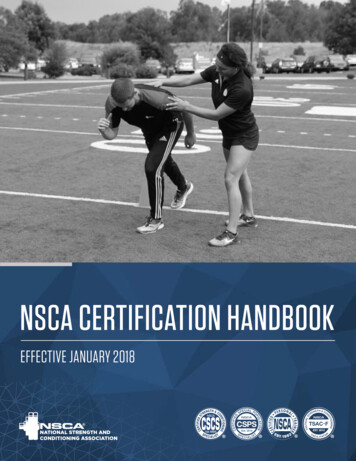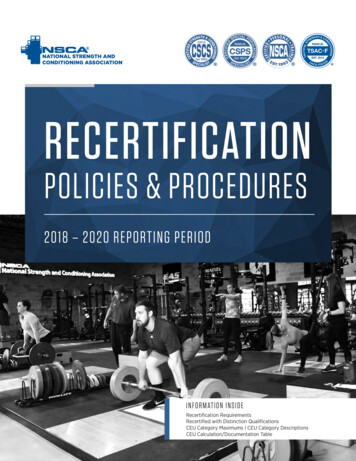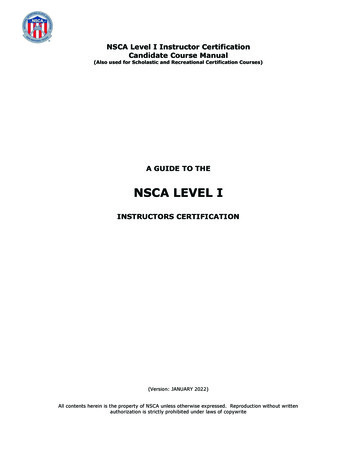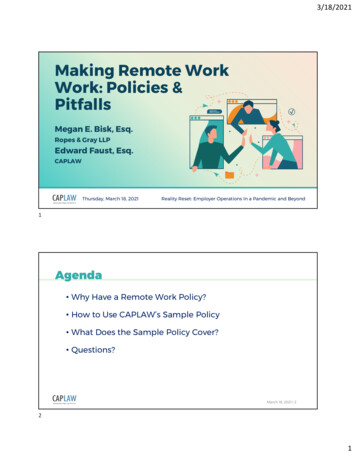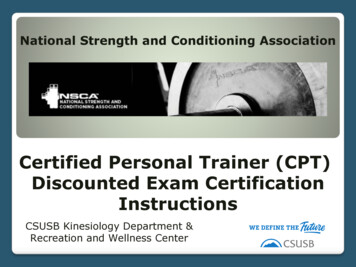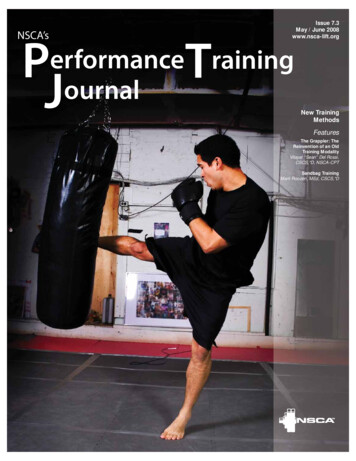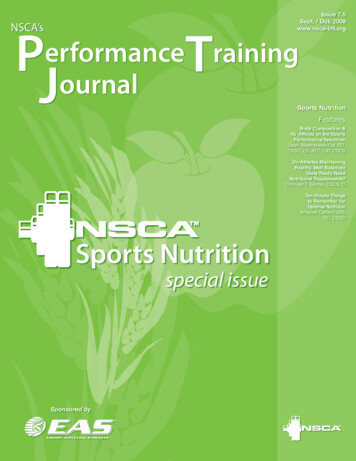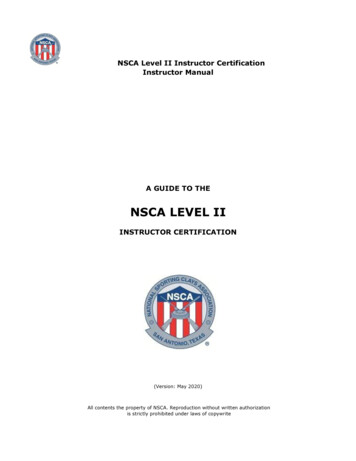
Transcription
NSCA Level II Instructor CertificationInstructor ManualA GUIDE TO THENSCA LEVEL IIINSTRUCTOR CERTIFICATION(Version: May 2020)All contents the property of NSCA. Reproduction without written authorizationis strictly prohibited under laws of copywrite
Table of ContentsI.Welcome Letter3II.Mission, Purpose, What to Bring and Acknowledgements4III.Admissions Guidelines, Criteria and Cost5IV.NSCA Philosophy of Instruction6V.Required Competencies71st. Safety & Positive Control82nd. Assessing Eye Dominance8VI.3rd. Assess Gun Fit124th. Teach the Fundamentals125th. Lead and Lead types126th. Problem Solving - “Getting the student to hit the target.”127th. Observation, Motivation and Communication Skills16Other topics17A. Reading the Targets17B. Lesson Plan / Lesson Log / Homework17C. Mental Game18VII. Post-Graduation222Version: May 2020NSCA Level II Certification Manual 2020 – NSCA
Dear Level II Instructor Candidate:Congratulations on your progression as an NSCA instructor. On behalf of the InstructorCommittee and the staff of the NSCA, welcome to the NSCA Level II Instructor CertificationCourse. By attending this course, you have taken a major step in furthering your education asa senior instructor within the ranks of the NSCA Instructor Corps. This 3-day course, as well asthe 4-day Level III Course, is unique to North America as the only nationally recognizedadvanced shotgun instructor courses in the clay target disciplines of Sporting Clays andFITASC. While the NSCA Level I Course is widely recognized as the finest course in NorthAmerica for training shotgunning instructors, an instructor attending and passing therequirements of the NSCA Level II Course is recognized as an advanced diagnostician. Simplyhaving been a Level I instructor for 2 or more years and having taught a minimum of 500hours of instruction is only the beginning of our expectations.In short, a Level II Certified Instructor is expected to possess an advanced level of diagnosticand instructional ability and able to readily recognize and solve the challenges of shooters,whether the student is a beginner, novice or more advanced competitor. It is assumed that, asa Level II Instructor Candidate, you already possess a level of diagnostic and instructional skilldramatically beyond that of a Level I or beginning level instructor. These skills will have beenlearned through teaching, being mentored and by ongoing continuing education and selfstudy. As an instructor progresses to higher levels of NSCA certification, the purpose of thecertification course becomes less content driven and increasingly evaluative in nature. Whilethe Level I course is designed to teach shooters how to teach beginning and novice students,the purpose of the Level II course is to deepen your understanding of some of the conceptsyou are already familiar with, like eye dominance, gun fit, lesson plans and the mental game,while simultaneously evaluating your abilities as an advanced instructor to determine whetherthey warrant a Level II Certification.There is always room for improvement and enhancement of any of our courses, so we inviteyour comments on ways in which we can improve this course and the program. Thank you fortaking this major step and joining the many certified instructors who preceded you in elevatingthemselves to the ranks of the NSCA’s advanced instructors.Sincerely,Chief InstructorNational Sporting Clays AssociationNSCA Level III Instructor3Version: May 2020NSCA Level II Certification Manual 2020 – NSCA
II. Mission, Purpose and AcknowledgementsMission StatementThe NSCA will deliver the most consistent and highest possible quality of instruction tosporting clays and FITASC shooters at all levels of shooting proficiency by training,maintaining and supporting a highly competent instructor corps and delivering the mosteffective curriculum possible, stressing safety and the fundamentals of good shotgunning.Purpose of the Level II Course and Certification: As an instructor progresses through thevarious levels of NSCA certification, the purpose of each certification course becomes lesscontent driven and increasingly evaluative in nature. The purpose of the Level II course is toprepare you to be a coach, deepen your understanding of concepts you already know whileevaluating your ability to diagnose and solve more complex challenges with more advancedshooters. Level II Certification requires a high level of expertise, with an emphasis on accuratediagnostics and solid communication skills. The Level II Certification Course includesclassroom presentations, shooting and hands-on teaching exercises during three days ofintensive training. A sound knowledge of the fundamentals and solid diagnostic skills are vital,as well as the realization that there are no advanced shooting techniques, just advancedapplications of the basic principles.Candidates must be able to safely instruct a wide variety of shooters, up to advance-levelcompetitors, in sporting clays and FITASC. Level II Instructors are encouraged to be activecompetitors who will encourage their students to compete in the sport as well as promote thesport to new shooters. In addition to demonstrating your mastery and retention of Level Icompetencies, the Level II candidate must demonstrate strong communications and advanceddiagnostic skills; be highly proficient at teaching the fundamentals of shotgunning, assessingand addressing eye dominance and gun fit challenges and diagnosing and addressing the rootcause of a shooter’s miss. Because the Level II instructor will be teaching more advancedshooters, it is essential that the candidate be able to diagnose more complex gun fit and eyedominance issues and the causes of misses on targets of more advanced levels of difficulty. Aswith the other certification levels, the program encourages certified instructors to continue theirlearning process through teaching, shooting, individual study and seeking the assistance andadvice of one or more instructor mentors. Successful completion of this course to the Level IIstandards will entitle the graduate to advertise as a Certified NSCA Level II Instructor and seekclients for instructional services.What to bring:You are expected to bring at least 150 shells, your shotgun, vest/pouch, eye/ear protection,notebook, lesson/log book and cash/check to remit your portion of the Certifying Instructor’sExpenses (see “Cost” below). Additionally, as an experienced instructor, you are expected tobring your “instructor bag” with you. Most instructors will carry extra earplugs; extra shootingglasses, visual aids and whatever else is needed to make field expedient modifications to gunfit and intervene to fix eye issues. On the instructor portion of the NSCA website, under“Instructor Support Materials”, you will find an “Instructor’s Tool Kit” with a list of items youmight want to consider including in your own tool kit.Acknowledgements:Since the origins of the NSCA’s Instructor Program, many have contributed to the coursecontent and the way in which the courses are now conducted. The influence of manycontributors is evident on the pages of the course manuals and we extend our thanks to NSCA4Version: May 2020NSCA Level II Certification Manual 2020 – NSCA
instructors who, over the years, have had a hand in the development of the NSCA InstructorProgram.III. Admissions Guidelines, Criteria and Cost1.Applicants must be active members in good standing of NSCA.2.Applicants will be active Level I Instructors with at least two years of instructionalexperience as a Level I Instructor and will have taught a minimum of 500 clockhours of instruction (clock hours are counted as actual/total instructional hours forexample, a 4-student clinic running 3 hours in length is considered 3 hours ofinstruction, not 12).3.In addition to meeting all of the Level I prerequisites and certification requirements(READ THE LEVEL I MANUAL!) and complying with all NSCA Safety Rules andshooting range safety protocols during the course, the Level II instructor should bea strong communicator and an advanced diagnostician highly proficient at teachingthe fundamentals of shotgunning, assessing and addressing eye dominance andgun fit challenges and diagnosing and addressing the causes of a miss. Becausethe Level II instructor will be teaching more advanced shooters, it is essential thatthe Level II Instructor be able to diagnose more complex gun fit and eyedominance issues as well as the causes of a miss on targets of more advancedlevels of difficulty.4.As in the Level I course, only a 100% safe shooting environment will beacceptable. Candidates are solely responsible for their personal safety, the safetyof their students and the safety of range personnel. The ability to pay attention toevery detail is essential.5.Candidates must have taken a minimum of 8 hours of lessons from a Level II, IIIor equivalent instructor (as approved by Chief Instructor) at some point prior toattending the Level II Course.6.Shooting Proficiency Requirement – Each candidate must prove reasonableproficiency at engaging clay targets with a shotgun by either, 1) having at one timeearned a minimum of an NSCA A Class rating and shot a minimum of 6,000lifetime registered targets, OR 2) during the Level II course, demonstrate anequivalent proficiency level with a shotgun. Since the purpose of the Level IIInstructor Course is to evaluate and train instructors in how to effectively teachstudents up to and including advanced-level competitors, the Level II candidateshould have attained a minimum shotgun-shooting competency level. You don’thave to be a champion shooter to be a Level II instructor but the Level IIInstructor should be able to teach students how to break the level of targets theirstudents are attempting to engage. The Level II proficiency requirement is definedas the ability to break 75% or more of a broad assortment of targets that is of alevel of difficulty that surpasses the Level I Shooting Proficiency Test and ischallenging to a shooter that has earned a rating of A Class or above.5Version: May 2020NSCA Level II Certification Manual 2020 – NSCA
COSTTuition is 750 for the three-day course plus shells, target costs and a shared portion ofexpenses for the Certifying Instructor(s). Certifying Instructor (CI) expenses will vary with thedistance the CI is required to travel for the course, overnight stays required, materials andwhether a rental car is required. This cost is divided equally among the instructor candidateswho attend the class.IV. THE NSCA PHILOSOPHY OF INSTRUCTIONThe best way to describe the NSCA’s philosophy of instruction is – “keep it safe, keep it simpleand have fun.” We want all aspects of the program to be simple to understand, simple toteach and simple to communicate. As an instructor, you are in the communication andentertainment business – talking, listening, negotiating, motivating, encouraging andconsoling. The biggest obstacle to success that we find with most intermediate instructors andcoaches is that they deliver too much information and provide excessively lengthy verbalsolutions to problems. It is much easier for the student to understand a short and directsolution than it is to listen to a five-minute verbal dissertation from the coach. Remember, thestudent will usually only remember the last one or two things the coach says during a lesson.When it comes to teaching, “less is more.” For candidates who are high-performingcompetitors, the most common obstacle to success that we see is inflexibility; an inability toadapt to individual students and teach multiple styles. “My way or the highway” doesn’t workin coaching. To be a really great coach, you have to be a bit of a chameleon. To be aneffective coach, you must teach the fundamentals with consistency but adjusting and adaptingyour delivery and teaching style to the aptitudes, preferred technique, experience level,commitment level and available time and resources of the individual student. Make sure youreview the four major learning styles and seven teaching styles described in the Level Imanual.As you know from your experience, much of the art and science of teaching is learning to askquestions of your students in order to find the correct teaching method based on their learningstyle. Teaching more advanced students and teaching novice students more effectively is bestaccomplished by a student and instructor learning to communicate and cooperating to solveeach problem.Effective communication requires creativity. Simply telling a student what you see will usuallynot result in effective learning. To be clear, telling a student where they missed is NOT thecorrect way to guide a student to breaking a target. Lead is almost never the problem and isalmost always a symptom of the problem. In most circumstances, if you fix the cause of amiss, the lead will fix itself. There is very little expected of a Level I Instructor Candidate withregard to diagnostics and creativity. The beginning instructor lacks the experience, mentoringand instructional hours necessary to possess a wide variety of ways to solve the sameproblem, customized to the way an individual student most effectively learns. As a Level IIcandidate, however, you are expected to have developed a wide array of techniques and“word tracks” to fix the shooting challenges of your students. Having a physical “tool box” isone thing. One major objective of the Level II Course, however, is for you to add to your “toolbox” of techniques as you work with your CI and other instructor candidates during thecourse.6Version: May 2020NSCA Level II Certification Manual 2020 – NSCA
V. REQUIRED COMPETENTCIES(****Not everyone passes the Level II course. Please be sure to carefullyweigh your experience and expertise before signing up for the course.****)Each Level II Candidate is required to demonstrate competency in a variety of tasks acrossseven competency areas .the same seven competency areas required to pass the Level Icertification except that, for some competencies, a higher level of demonstrated mastery isrequired for certification. Additionally, you must achieve a minimum score of 80% on the LevelII course examination administered during the course. It is absolutely critical that youstudy the Level I manual in parallel with this Level II manual. Level II candidatesare expected to know and be proficient in the competencies outlined in the currentLevel I AND Level II manuals in order to be certified as a Level II Instructor. Thefollowing tasks must be performed on a pass/fail basis to the standard(s) and under theconditions indicated for each task below (or as stated in the Level I manual when the standardis the same for both Level I and Level II). In an effort to assist Candidates in mastering eachof the tasks required, the CI will provide any and all reasonable assistance to each Candidateduring the course. If, however, large gaps exist in an individual candidate’s knowledge orproficiency in diagnostics or communications, it will be difficult if not impossible to addressthese during the course of the class.You will find similarities between the Level I and Level II Certification Courses because allshooting is built from the same basic principles. There are no advanced principles, onlyadvanced applications of the basic principles. As stated earlier, however, a higher standard ofdiagnostics, problem solving and communications will be expected and required for Level IICandidates. For example, if a Level II candidate encounters a student with gun fit and eyedominance issues that effect his or her performance, the Level II Instructor must be able toproperly identify, diagnose and address the student’s challenges. In addition, the Level IICertification Course will provide Candidates with training in the mental game. Learning tocontrol anxiety and having a solid pre-shot routine is a major part of becoming a better andmore consistent shooter. As an instructor of more advanced students, you must be equippedwith the tools to help your students in this area of their game.General Discussion:The NSCA Level II Course cannot replace experience. The knowledge gained from instructingstudents is far more transformational than a three-day course could ever be. However, it isour intent that the NSCA Level II Course will help propel your learning, shorten the learningprocess and reduce painful errors by teaching you the principles of coaching based on thecollective wisdom of successful coaches that have come before you.What is the difference between an instructor and a coach? Rainer Martens, in his classic text"Successful Coaching”, says that a good coach should have "the teaching skills of an educator,the training expertise of a physiologist and the counseling wisdom of a psychologist."-"Successful coaches help (students) master new skills, enjoy competing and develop selfesteem. Successful coaches are not only well versed in the technical and tactical skills of theirsport, but they also know how to teach these skills and direct their (students) in theperformance of these skills." Most coaches have learned the skills of coaching through years oftrial and error.7Version: May 2020NSCA Level II Certification Manual 2020 – NSCA
According to Rainer Martens, “A mediocre coach tells, a good coach explains, a superior coachdemonstrates, but the great coach inspires.” With the help and guidance of a successfulinstructor, students will master new skills while enjoying the competition and developing theirself-esteem. As a seasoned instructor, you must be on a never-ending quest to hone yourcraft and learn new skills. While steadfast in your principles, you must be a chameleon in yourdelivery: able to change techniques and approaches based on the needs of your student with aregular and healthy dose of self-evaluation.COMPETENCY #1: Safety and Positive Control(Same as Level I)Task #1-1: Individual Safety Responsibility Task #1-2: Safety & Positive ControlCOMPETENCY #2: Assessing Eye Dominance(Refer to the Level I Manual, as well as the following. Same Task and Condition as Level Iexcept that a higher standard of diagnostics and problem solving will be expected andrequired.)Task #2-1: Determine a shooter’s eye dominance statusTask #2-2: Employ appropriate response to eye dominance issues effectingperformanceDISCUSSION:As experienced shotgun instructors, we simply must be able to accurately diagnose andaddress eye dominance and gun fit issues in order to clear the way for a student to experiencesteady progress and performance improvement. It is very common to see shooters who havestruggled with their shooting for years and for whom the cause of their struggles is rooted ineither eye dominance or gun fit.In addition to the information contained in the Level I Manual (Competency #2), the followingis a “solution protocol” designed to guide experienced instructors as they attempt to properlyrespond to students/shooters with a variety of eye dominance statuses (Task #2-2). Eyedominance involves the neuro-pathways between the eye and the brain. The way in whichindividual shooters respond to a clay target will differ because everyone’s “visuo-motorsystem”1, including the eyes, brain and body, work differently. Therefore, you should use thefollowing table with caution. It is not uncommon for shooters, or their well-meaninginstructors, to put a piece of tape on the glasses of a student to help them hit targets whenthe reason for the miss is something else entirely. As a Level II Candidate, you are expectedto be able to observe a pattern of misses and accurately diagnose the cause; whether eyedominance anomaly, gun fit, bad mount, insufficient visual focus or another cause. Aninstructor should never “assume” that a shooter has an eye dominance problem butshould first presume that the student is either mounting incorrectly, has impropergun fit (too much drop at comb) or is not applying sufficient visual focus to thetarget. For the purposes of this discussion, however, let’s assume that you are instructing a1Vickars, Joan. The Quiet Eye in Action: Perception, Cognition and Decision Training. Human Kinetics, 2007. Print.8Version: May 2020NSCA Level II Certification Manual 2020 – NSCA
student that is experiencing a particular pattern of misses, for example, a right-handedshooter consistently missing a left-to-right quartering away target, high and behind. You haveeliminated the possibility that the cause of this pattern of misses is gun fit, lack of visualfocus, flawed movement or some other cause and have determined that the cause is an eyedominance anomaly. As mentioned in the Level I Manual, there are no hard and fast rulesregarding eye dominance although there are common patterns and symptoms that provide theobservant instructor with insight about the cause and proper resolution. Again, everyone isdifferent so be cautious in your approach to applying occlusion devices (patches, dots, etc.) tothe eyeglasses of your students. Corrective action should NEVER be undertaken by aninstructor without: 1) testing for and understanding the students eye dominance status, 2)seeing the student attempt to engage targets, and 3) seeing the student miss on certain“telltale” targets on which eye dominance anomalies would normally cause a miss. When andif you employ an occlusion device of some sort, you should always start with the “leastinvasive” or least amount of occlusion and work your way toward greater occlusion until theproblem is alleviated.So, your student is experiencing a pattern of misses on certain types of targets and you areconvinced that the student has an eye dominance anomaly which can’t be solved by simplyhaving the student focus more intensely on the target. What do you do? You are now enteringinto a realm of problem solving that is every bit as much art as science. The student is missingthe targets due to the fact that the brain is receiving target guidance information from thenon-shooting eye. In order to remedy this situation, and enable the shooter to correctly placethe gun on the target, you must occlude (block, “handicap” or limit the influence of) the nonshooting eye. Winking the eye is always an option. However, the winking of an eye is prone toproduce inconsistent results. Some students will partially close, or “shutter”, the eye instead offully winking, causing some inconsistency. Additionally, a student may time the wink a bitdifferently from shot to shot; once again causing some inconsistency that is very difficult forthe instructor to diagnose. If you opt to use an occlusion device, you now have to determinewhat level of occlusion is needed.9Version: May 2020NSCA Level II Certification Manual 2020 – NSCA
Eye Dominance Assessment and Likely Course of ActionEye dominance assessmentShootingside?InterventionRequired? *RightNoSolidly leftLeftNoSolidly right. (student missinghigh and right**)LeftYesSolidly left. (student missinghigh and left**)RightYesPrimarily right, with shift towardcenter/left.RightUnknown /possiblyPrimarily left, with shift towardcenter/right.LeftUnknown /possiblyPrimarily right, with shift towardcenter.Primarily left, with shift towardthe center.Center ocular / co-dominant(may slightly favor the left orright side).LeftYesRightYesRightLikelyLeftLikelySolidly rightCenter ocular / co-dominant(perhaps even very slightlyfavors the left or right side).If yes, what is most likelyrequired?Shooter is “crossdominant”. Have studentmount the gun on theright side***Shooter is “crossdominant”. Have studentmount the gun on the leftside***If student consistentlymissing high and left, mayneed to place occlusion foilon left eye **If student consistentlymissing high and right, mayneed to place occlusion foilon right eye **Have student mount thegun on the right side***Have the student mountthe gun on the left side***Student may have atendency to miss high andleft. If needed, placeocclusion foil or solid doton left eye.**Student may have atendency to miss high andright. If needed, placeocclusion foil or solid doton right eye.*** Once again, corrective action involving applying any sort of occlusion device or recommendingthat the student close an eye, should NEVER be undertaken unless and until the instructor first:1) tests the student’s eye dominance, 2) observes the student attempt to engage targets, AND3) observes the student miss on certain “telltale” targets (targets for which eye dominanceanomalies would normally cause a miss).** While shooting with both eyes open*** see Discussion and Scenario’s in Level I Manual10Version: May 2020NSCA Level II Certification Manual 2020 – NSCA
An instructor who “overcorrects” and unnecessarily blocks the non-shooting eye is doing adisservice to the shooter because occlusion will limit some of the useful information flowing tothe brain from the non-shooting eye. Some experimentation is required to arrive at the rightlevel of occlusion for the student. Always start with the least amount of occlusion and workyour way into that level of occlusion necessary to allow the shooting eye to dictate shotplacement. We will discuss this in much greater detail during the class.When applying occlusion devices, the following is a very general set of guidelines to follow. Asstated earlier, you can’t generalize and apply a “one-size-fits-all” approach. Everyone is a bitdifferent.Occlusion nativeNoneNothingn/aVerylightShotspot 1.0(rarely effective)LightShotspot 0.8 or20/25 FoilsModerateShotspot 0.6 or20/50 FoilsHeavyShotspot 0.3 or20/70 FoilsVeryHeavy20/100 FoilsUsing a white board marker (e.g., EXPO), make asmall pattern of dots on the outside of the glasses,wink the non-shooting eye.Using a white board marker (e.g., EXPO), make asmall pattern of dots on the outside of the glasses,wink the non-shooting eye.Using a white board marker (e.g., EXPO), make asmall pattern of dots on the outside of the glasses,wink the non-shooting eye.Using a white board marker (e.g., EXPO), make asmall pattern of dots on the outside of the glasses,wink the non-shooting eye.Very thin film of Chapstick (apply a very tiny amountwith finger), Scotch tape, wink the non-shootingeye.Scotch tape, electrical tape, Chapstick, wink the nonshooting eye.TotalMorgan Magic EyeDots*Note: These are just guidelines.Size of occlusion device:12 mm (average size of pupil) for shooters with a very consistent mount16 mm (1.59 cm) for shooters with a less consistent mount* Note: Cutting a Morgan Magic Eye Dot into 12mm or 16mm diameter circles maximizesperipheral vision for the shooter and is quite effective when this level of occlusion is called for.Placement: If you determine that an occlusion device (dot, spot, Chapstick, tape) is required,placement of the dot is critical. The device must be placed such that, when the shooter has thegun fully mounted, the center of the device (spot, dot, etc.) should be aligned directlybetween the pupil of the non-shooting eye and the front bead of the shooter’s shotgun. If notproperly placed, the shooter will be able to see around the dot during shot execution and thiswill defeat the purpose of the device.11Version: May 2020NSCA Level II Certification Manual 2020 – NSCA
COMPETENCY #3: Assessing Gun Fit(Refer to the Level I Manual, as well as the following.)Task #3-1: Check Gun Fit(Same Task and Condition as Level I except that a higher standard of diagnosticsand problem solving will be expected and required.)Task #3-2: Field Expedient Gun Fit (Level II Only)Candidate will take whatever measures are necessary to ensure that the studenthas a generally well-fitting shotgun for the lesson.Condition: The Candidate is presented with a student in a field setting with ashotgun that does not fit.Standard: Candidate will take whatever measures necessary and reasonable toAbove: (as seen byfit the shotgun to the student for the lesson. Candidate will employ one or moreinstructor from theof the following methods: adjusting the comb (if comb is adjustable),muzzle-end of thechanging/modifying butt pad for length of pull and or pitch, using “tradecraft”barrel) Properequipment (e.g., slip-on butt pad extension, comb riser, spacers, duct tape,placement of themoleskin, or any other means to get the job done) and/or changing guns. It isiris/eye over barrelexpected and assumed that the Candidate will have assembled, and have inrib when shotgun fitsthe shooter.his/her possession during the course, an “instructor bag” with an assortment ofitems needed to modify a shotgun to fit a student to an ill-fitting shotgun. It isexpected that, when the gun is fitted properly, the student’s iris will be generally alignedwith the center of the shotgun rib (left-to-right / horizontally) and that the iris would besitting on top of the rib vertically.COMPETENCY #4: Teaching the Fundamentals(Same as Level I)COMPETENCY #5: Lead and Lead Types(Same as Level I)COMPETENCY #6: Problem Solving - “getting the student to hit the target.”Task# 6-1: Identify Placement of a miss(Same as Level I)Task# 6-2: Identify the cause or reason for a miss (Mandatory for Level II) Candidatewill correctly identify the cause or reason(s) for a student’s miss on one or more targets.Condition: Candidate instructing a student and the student exhibiting difficulties in engaginga target.Standard:Candidate will accurately attribute a student’s miss to one or more causes to the CertifyingInstructor:A. Insufficient focus on the target / Failure to visually fix on the target.12Version: May 2020NSCA Level II Certification Manual 2020 – NSCA
B.C.D.E.F.G.Poor ready positionWrong lead pictureGun off line / “spoiled the line” (gun placed between the eye and the target)Comb not in contact with cheekPoor movement / mountPainTask #6-3: Candidate will effectively communicate with the student to resolve the student’schallenges in engaging and breaking targets. (i.e. demonstrate to the CI
Congratulations on your progression as an NSCA instructor. On behalf of the Instructor Committee and the staff of the NSCA, welcome to the NSCA Level II Instructor Certification Course. By attending this course, you have taken a major step in furthering your education as a senior instructor within the ranks of the NSCA Instructor Corps.

